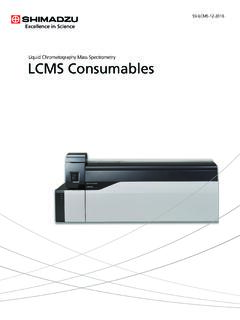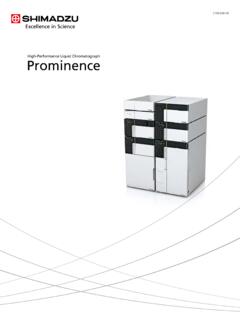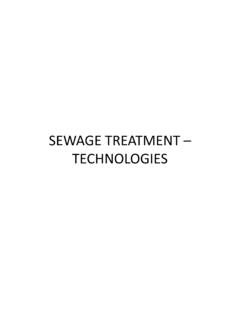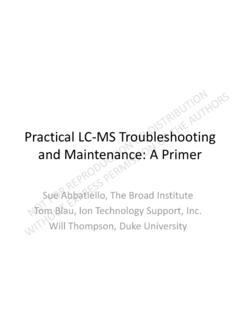Transcription of CANNABIS ANALYSIS AND TESTING - Shimadzu
1 32 The CANNABIS industry is growing exponentially and the use of marijuana for medical purposes is being adopted across the nation. With this boom in CANNABIS consumers, there has been an increasing need for knowledge about the product. The role of TESTING labs has become crucial to the process, which makes owning and operating a lab more and more lucrative. Scientists TESTING for potency, heavy metals, pesticides, etc. are able to make meaningful contributions to the medical industry by making sure products are safe, while simultaneously generating large profits and a significant return on investment. This start-up guide is designed to inform and guide decisions regarding how to best furnish a laboratory with the sole purpose of TESTING any medical CANNABIS product or marijuana-infused product. Tests include potency, heavy metals, pesticides, bacterial, fungi, mycotoxins, residual solvents, and moisture content with recommended equipment, preparation, estimated cost, revenue and ROI.
2 Note the instrument prices are shown as list price, not selling price. The ROI calculations are intended for general reference only; Shimadzu does not guarantee TESTING volumes nor prices. The ROI calculation doesn t include the salary of the worker. Also, before each ROI calculation, the more expensive consumables are described but are not included in the ROI calculation. This is not a comprehensive list of consumables, but a high level look at weekly consumed items. There are considerable lab start-up costs outside of instrumentation, around $25,000 to $35,000. If there is interest in start-up costs, request Shimadzu s Start-Up document. This guide will take into account most state regulations. CANNABIS analytical TESTING requirements may vary by state, so be sure to check out your state regulations ANALYSIS AND TESTINGP otency TestingHeavy Metals TestingPesticide TestingResidual Solvents TestingMicrobial, Fungus, & Mycotoxin TestingMoisture Content TestingTerpene Profile Testing4 The most important component of CANNABIS TESTING is the ANALYSIS of cannabinoid profiles, also known as potency.
3 CANNABIS plants naturally produce cannabinoids that determine the overall effect and strength of the strain. There are many different cannabinoids that all have distinct medicinal effects. However, most states only require TESTING and reporting for the dry weight percentages of tetrahydrocannabinol (THC) and cannabidiol (CBD).EQUIPMENTFor potency TESTING , traditional high performance liquid chromatography (HPLC) is recommended and has become the gold standard for analyzing cannabinoid profiles. RECOMMENDED INSTRUMENTFor this TESTING , Shimadzu offers the CANNABIS Analyzer for Potency. This is the only instrument in the market designed specifically for CANNABIS potency profiling. This turnkey HPLC analyzer delivers a comprehensive package that integrates instrument hardware, software, consumables, and proven HPLC methods to meet your analytical needs.
4 SAMPLE PREPARATIONW eigh 200 mg of flowers or cuttings into a 50 mL centrifuge tube. Add two mm steel balls into the tube. Shake at 1000 rpm for 1 minute with the SPEX 2010 Geno/Grinder . Add 20 mL of methanol to the tube. Shake at 1000 rpm for 1 for 15 minutes. Mix using a vortex mixer for 1 minute. Transfer 1 mL of the mixture into a mL micro-tube and centrifuge at 3000 rpm for 5 100 L of supernatant to a new mL micro-tube. Add 900 L of methanol. Filter the mixture through a m syringe filter and transfer to a mL sample TESTINGMost states only require TESTING and reporting for THC and , REVENUE AND ROI BREAKDOWNC annabis Analyzer for Potency: Instrument Cost: $55,000 List Price Estimated Weekly Operating Cost (1 Week): Flow rate: mL/min Solvent A*: Formic Acid in Water Solvent B*: Formic Acid in Acetonitrile Water, HPLC Grade, JT Baker, six 1L bottles: $ Acetonitrile, JT Baker, six 1L bottles: $ *It is highly recommended to use only HPLC or UHPLC grade solvents.
5 All calculations are assuming operation of 8 hours a day and 5 days a week. These calculations also assume there are enough samples to keep the analyzer constantly running. If you run at mL/min of water and acetonitrile 50:50 mix, operating for one week, you will go through 45 mL/hour of water and 45 mL/hour of acetonitrile. This yields 1800 mL/week of both acetonitrile and water. You will expect to go through two 1L bottles of each. At the case price, this means you will spend $ on water and $ on acetonitrile for a total operation cost/week of $ standards are run periodically, but every organization has different Standard Operation Procedures (SOPs) of how frequently they are 8 Hour Day/5 Days a WeekHigh ThroughputHigh Sensitivity# Cannabinoids Measured1011 CannabinoidsTHC, d8-THC, THCA, CBD, CBDA, CBDV, CBN, CBG, CBGA, CBCTHCV, THC, d8-THC, THCA, CBD, CBDA, CBDV, CBN, CBG, CBGA, CBCE xpected Revenue/Sample$50 $50 Total Run Time (minutes)810 Samples/Day6048 Samples/Week300240 Expected Revenue/Week$15,000 $12,000 Instrument Cost$55,000 $55,000 Break Even (weeks) on Investment (ROI) Calculation for Potencyrerun and thus a total cost can t be listed.
6 However, to provide a concept of costs, the 10 mix cannabinoid standard (P/N 220-91239-20) sells for $750, while the 11 mix cannabinoid standard (P/N 220-91239-21) costs $ are the costs of two methods developed by Shimadzu with the High Throughput Method for ANALYSIS of 10 cannabinoids and the High Sensitivity Method for ANALYSIS of 11 cannabinoids. Also, periodic replacement of the Consumable Guard Column (3/pk @ $750) and Analytical Column ($750) are types of metals can be found in soils and fertilizers and as CANNABIS plants grow, they tend to draw in these metals from the soil. Heavy metals are a group of metals considered to be toxic, and the most common include lead, cadmium, arsenic and mercury. Most labs are required to test and confirm that samples are under the allowable toxic concentration limits for these four hazardous metal TESTING is performed by inductively coupled plasma mass spectrometry, or ICP-MS.
7 ICP-MS uses the different masses of each element to determine which elements are present within a sample and at what concentrations. HEAVY METALS TESTING RECOMMENDED INSTRUMENTFor this TESTING , Shimadzu recommends the ICPMS-2030. Included in the ICPMS-2030 software are two assistant functions that simplify ANALYSIS . The Development Assistant simplifies the process of developing analytical methods, whereas the Diagnosis Assistant automatically diagnoses spectral interference. Together, they provide analytical results with exceptionally high reliability and unparalleled ease of operation. In addition to the user-friendly software, a unique hardware system developed by Shimadzu , including the proprietary mini-torch, results in a reduction of the consumption of argon gas and electricity. Furthermore, the plasma ignition sequence is optimized for lower-purity Argon gas ( , Argon as opposed to more expensive used by other manufacturers).
8 Combined, this results in the industry s lowest running costs among ICP-MS PREPARATIONS imilar to HPLC prep, you will need a liquid sample to introduce to the ICP-MS. This is commonly accomplished by using a microwave digestion process. The samples are first weighed and then placed in a vessel that contains a small amount of acid (usually HNO3 or nitric acid, though hydrochloric acid is also acceptable). This dissolution process on its own could take hours, so the incorporation of the microwave digester speeds up the process dramatically. Once digestion is complete, the sample is rinsed out of the digestion container and placed in a sample vial. It is then inserted into the autosampler of the ICP-MS and the ANALYSIS , REVENUE AND ROI BREAKDOWNICP-MS: Instrument Cost: $125,000 List Price Estimated Weekly Operating Cost (1 Week): 1 Dewar of Argon Gas (Pure): $1,250 You will typically run about 10 Liters/min of argon through the system when it is in use.
9 A 230 liter of liquid argon Dewar yields 180,492 liters of gaseous argon. Thus, the Dewar will run an ICP-MS for 18,049 minutes or about 300 hours or weeks. Price of gas per week: $ Also ask about Shimadzu s ICPMS-2030 Cost of Ownership document where cost per sample over a one year period is approximately $1 calculations are assuming operation of 8 hours a day and 5 days a week. These calculations also assume there are enough samples to keep the analyzer constantly running. 8 Hour Day/5 Days a WeekROIE xpected Revenue/Sample$50 Total Run Time (minutes)5 Samples/Day96 Samples/Week480 Expected Revenue/Week$24,000 Instrument Cost$125,000 Break Even (weeks) on Investment (ROI) Calculation for Heavy Metals by ICP-MS12 The detection of pesticides in CANNABIS has been a challenge. There are many pesticides that are used in commercial CANNABIS grow operations to kill the pests that thrive on the plants and in greenhouses.
10 These chemicals are toxic to humans, so confirming their absence from CANNABIS products is crucial. A majority of states require labs to test for an average of 18 different for pesticides is one of the more problematic analyses, resulting in the need for two different instruments. For a majority of pesticides, liquid chromatography mass spectrometry (LCMS) is acceptable and operates much like HPLC, but utilizes a different detector and sample preparation. Pesticides that do not ionize well in an LCMS source require the use of a gas chromatography mass spectrometry (GCMS) instrument. The principles of HPLC still apply you inject a sample, separate it on a column, and detect with some detector. However, in this case, a gas (typically helium) is used to carry the INSTRUMENTSS himadzu recommends the LCMS-8050 which is a LC-MS/MS system or HPLC system with a triple quadrupole mass spectrometer.










